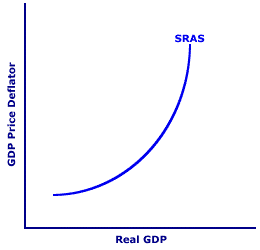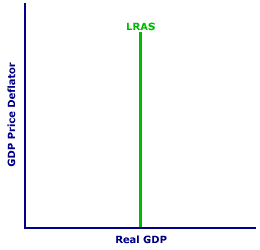
|
|
ZONING: Legal restrictions on where different activities can locate within a city. Most cities regulate the location of industrial, commercial, and residential activities. The underlying motivation behind zoning is to keep less desirable, but perhaps more profitable, activities from encroaching upon residential areas.
Visit the GLOSS*arama
|
|


|

|
                           RESOURCE QUALITY, AGGREGATE SUPPLY DETERMINANT: One of three categories of aggregate supply determinants assumed constant when the short-run or long-run aggregate supply curves are constructed, and which shifts both aggregate supply curves when it changes. An increase in a resource quality causes an increase (rightward shift) of both aggregate supply curves. A decrease in a resource quality causes a decrease (leftward shift) of both aggregate supply curves. The other two categories of aggregate supply determinants are resource quantity and resource price. Specific determinants falling into this general category include education and technology. Anything affecting the quality of labor, capital, land, and entrepreneurship is also included. This determinant category is based on the presumption that quality affects the productivity of resources. Workers with better education are more productive. Capital that uses the latest technology is more productive. In other words, the same QUANTITY of resources is able to produce more output at the same price or the same output at a lower price when resource QUALITY is higher. The result is shifts of both the SRAS and LRAS curves. In particular, if resource quality improves, then aggregate supply increases and both aggregate supply curves shift rightward. With a decline in resource quality, aggregate supply decreases and both curves shift leftward.Two ExamplesThe two most notable determinants that affect resource quality are education and technology.- Education: Education includes formal, college-type, get-a-degree education and informal on-the-job training and learn-by-doing experiences. Both affect the quality of labor. Higher quality labor, brought about by more education, is more productive and causes both aggregate supply curves to increase. Of course, it is also possible for less education to reduce the quality of labor and cause both aggregate supply curves to decrease.
- Technology: Technology is the information that the economy has concerning production techniques. Technology generally affects the quality of capital, but can also peripherally affect the quality of labor, land, and entrepreneurship. In modern times, technology has generally advanced, causing increases in the quality of capital and thus increases in aggregate supply. It is, however, possible for a technological backstep that would cause a decrease in the quality of capital and aggregate supply.
Shifting the Curves| Shifting the SRAS Curve |  | Shifting the LRAS Curve |  |
To illustrate how a resource quality like education or technology shifts the short-run aggregate supply curve, consider the exhibit to the right. This exhibit displays a representative, positively-sloped short-run aggregate supply curve in the top panel and a standard, vertical long-run aggregate supply curve in the bottom panel. Like all aggregate supply curves, these are constructed based on several ceteris paribus aggregate supply determinants, such as education and technology. The key question is: What happens to these aggregate supply curves if resource quality changes?Higher Resource QualitySuppose, for example, that education or technology advances. This improvement in a resource quality leads to an increase in aggregate supply, causing both aggregate supply curves to shift rightward. Note that the advance in resource quality makes it possible to supply to supply a larger quantity of real production at the same price level, which is an increase in aggregate supply.To see how an improvement in resource quality affects these aggregate supply curves, click the [Higher Resource Quality] button. The greater resource quality triggers an increase in aggregate supply and a rightward shift of both the short-run and long-run aggregate supply curves. Lower Resource QualityAlternatively, suppose that education or technology declines. This drop in a resource quality leads to a decrease in aggregate supply, causing both aggregate supply curves to shift leftward. Note again that the fall in resource quality means a larger quantity of real production is supplied at the same price level, which depicts a decrease in aggregate supply.To see how a drop in resource quality affects these aggregate supply curves, click the [Lower Resource Quality] button. The lesser resource quality triggers a decrease in aggregate supply and a leftward shift of both the short-run and long-run aggregate supply curves. The Other Two DeterminantsResource quality is one of three categories of aggregate supply determinants. The other two are resource quantity and resource price. While resource quantity and resource quality affect both the long-run and short-run aggregate supply curves, resource price affects only the short-run aggregate supply curve.- Resource Quantity: This determinant includes any ceteris paribus factors that affect the quantity of labor, capital, land, or entrepreneurship used in production, such as population growth or change in the capital stock. An increase in resource quantity increases aggregate supply and shifts both long-run and short-run aggregate supply curves to the right. A decrease shifts both curves to the left.
- Resource Price: This determinant includes any ceteris paribus factors that affect the price of labor, capital, land, or entrepreneurship used in production. Two of the most notable resource price determinants are wages and energy prices. A decrease in resource price increases aggregate supply and shifts the short-run aggregate supply curve to the right. An increase shifts the short-run aggregate supply curve to the left.

Recommended Citation:RESOURCE QUALITY, AGGREGATE SUPPLY DETERMINANT, AmosWEB Encyclonomic WEB*pedia, http://www.AmosWEB.com, AmosWEB LLC, 2000-2025. [Accessed: July 18, 2025].
Check Out These Related Terms... | | | | | | | | | | | | |
Or For A Little Background... | | | | | | | | | | | |
And For Further Study... | | | | | | | | | | | |
Search Again?
Back to the WEB*pedia
|



|

|
PURPLE SMARPHIN
[What's This?]
Today, you are likely to spend a great deal of time flipping through mail order catalogs trying to buy either a flower arrangement for your aunt or a birthday greeting card for your uncle. Be on the lookout for rusty deck screws.
Your Complete Scope
This isn't me! What am I?
|

|
|
Mark Twain said "I wonder how much it would take to buy soap buble if there was only one in the world."
|

|
|
"A winner is someone who recognizes his God-given talents, works his tail off to develop them into skills, and uses those skills to accomplish his goals. " -- Larry Bird, basketball player
|

|
ICSID
International Center for the Settlement of Investment Disputes
|

|
|
Tell us what you think about AmosWEB. Like what you see? Have suggestions for improvements? Let us know. Click the User Feedback link.
User Feedback
|


|


